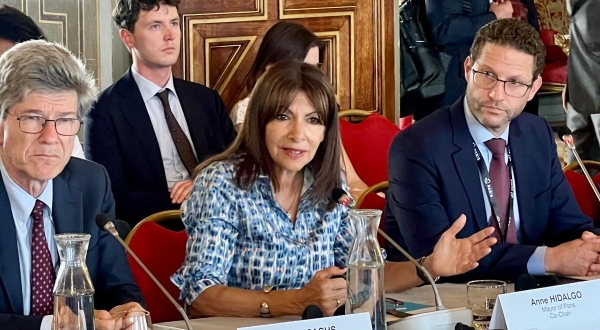Jessie Handbury on Shifts in Urban Living Patterns
Jessie Handbury is the Gilbert and Shelley Harrison Associate Professor of Real Estate at The Wharton School, University of Pennsylvania.
Jessie Handbury on Shifts in Urban Living Patterns
Jessie Handbury, Penn IUR Faculty Fellow, Wharton Professor, and economist with deep expertise in urban economics, has spent much of her career unraveling the complexities of cities, gentrification, and neighborhood transformation. In the wake of the COVID-19 pandemic, Handbury’s research has taken on new dimensions, examining how the economies of cities are shifting as workers, businesses, and residents adapt to a post-pandemic world. Her work is integral to understanding urbanization patterns, the revival of American cities, and the broader spatial sorting of income, all key components in how cities will evolve in the coming years.
The Urbanization of College Graduates and Neighborhood Change
In her influential 2023 paper, “Neighborhood Change, Gentrification, and the Urbanization of College Graduates”, Handbury and co-author Victor Couture explore the dynamics of urban neighborhoods that are increasingly shaped by the influx of college-educated individuals. In this study, Handbury identifies a clear shift: college graduates are not just moving into cities but are actively driving the changes in urban landscapes, particularly in the form of gentrification. The paper examines how this group’s relocation into previously less affluent neighborhoods accelerates processes of economic transformation, pushing up rents and property values, and altering the social and economic fabric of these areas.
Handbury’s findings reveal that while gentrification has often been seen through the lens of income inequality and displacement, it also signals a deeper trend in urban economies where the college-educated class increasingly populates urban areas, reshaping both the economy and the spatial organization of cities.
This movement, the paper argues, is not just about economic prosperity but also about the amenities that attract educated professionals—better public services, cultural vibrancy, and proximity to higher-paying jobs. These trends reveal important insights about urban economies: they are increasingly driven by human capital, and as more college graduates flock to cities, their presence drives significant economic and demographic changes.
Post-Pandemic Shifts in Urban Living Patterns
Handbury’s research in “Covid and cities, thus far” (2023) provides a further lens through which to view the resurgence of cities in the post-COVID era. In this comprehensive paper, Handbury and Gilles Duranton investigate the ways in which the COVID-19 pandemic has reshaped urban spatial structure and housing markets—particularly with the rise of remote work. Drawing on a monocentric city model, the authors analyze how reduced commuting costs and increased demand for residential space have altered patterns of housing consumption and location choices within and across cities.
Handbury and Duranton document a pronounced suburban shift in residential demand, with households relocating away from dense urban cores toward the periphery. Empirical evidence shows significant declines in rents and home prices in central business districts and corresponding increases in suburban areas, a phenomenon the authors describe as the "flattening" of urban price gradients. These changes, they argue, are consistent with classical urban economic models once adjusted to account for persistent remote work.
Beyond housing markets, the paper explores broader implications for urban form and function. The authors suggest that if remote work endures, it may undermine the density-dependent amenities and agglomeration effects that historically made downtowns vibrant places to live and work. As a result, downtowns may evolve to host a smaller, more selective class of creative, high-income workers who continue to value face-to-face interaction, while broader urban expansion could be driven by remote workers seeking larger homes in less dense environments.
The study underscores that the net welfare effects of remote work are modest and unevenly distributed. While remote workers benefit from reduced commuting and more flexible living arrangements, in-person workers—often lower-income—face higher housing costs without corresponding gains, exacerbating inequality. The authors conclude that although the long-term effects remain uncertain, the pandemic has triggered structural shifts in urban living patterns that are unlikely to fully revert.
Income Growth and the Spatial Sorting of Urban Amenities
In “Income Growth and the Distributional Effects of Urban Spatial Sorting” (2023) with Victor Couture, Cecile Gaubert, and Erik Hurst in the Review of Economic Studies, Handbury and her co-authors identify how income growth correlates with the sorting of amenities within urban areas. Abstracting from the specific nature of the amenities, their analysis reveals a fascinating trend: as cities grow economically, the spatial sorting of amenities becomes more pronounced. Higher-income individuals tend to concentrate in neighborhoods with more and better amenities, further exacerbating income inequality. This sorting, while reflecting broader economic forces, also highlights the challenges that cities face in balancing economic growth with equitable access to resources.
Through this research, Handbury offers new insights into how economic development is intertwined with urban geography. The study suggests that as cities become wealthier and more desirable, the distribution of resources becomes more unequal, with wealthier individuals and families able to cluster in areas where the amenities are most abundant. However, it also raises important questions about policy interventions and how cities can ensure that the benefits of economic growth are distributed more equitably across all income groups.
The Post-COVID City
As we look forward, Handbury’s research offers important insights into the future of urban economics in a post-pandemic world. She argues that cities will continue to be the centers of economic opportunity, cultural vibrancy, and innovation. However, the shape of these cities is changing: the migration patterns of college graduates, the revival of certain urban areas, and the growing importance of amenities are all reshaping the urban experience.
The question that remains is how cities will navigate the tension between economic growth and equitable access to urban resources. The gentrification that accompanies the influx of college-educated individuals can lead to increased inequality, while the concentration of income in wealthier neighborhoods exacerbates spatial segregation. How will cities ensure that growth benefits all residents, particularly those who are most vulnerable to displacement?
Handbury’s work provides a helpful framework for understanding these complex issues, offering both empirical evidence and a clear-eyed analysis of how urban economies are evolving. As cities continue to recover from the effects of the pandemic, Handbury’s research will undoubtedly play a pivotal role in shaping how policymakers, urban planners, and economists think about the future of cities—ensuring that these spaces remain vibrant, inclusive, and economically dynamic in an increasingly uncertain world.
Excerpt from Urban Revival in America
“Urban revival currently attracts considerable media attention and interest from the general public. Using census data, we show that this revival is indeed happening in almost all large U.S. cities and is driven by the location decisions of the young and college-educated. While the rest of the country continues to suburbanize, the young and college-educated flock downtown.
We evaluate the importance of various explanations for this trend. We find that diverging preferences for non-tradable services like restaurants and nightlife explain the diverging location decisions of the young and college-educated relative to other groups. Travel and expenditure shares of the young and college-educated also diverge from that of other groups, lending further credence to our model’s results.
It is, of course, important to identify the source of such changing preference parameters. Our investigation highlights the role of delayed family formation and top income growth. The young and college-educated are increasingly likely to be unmarried and childless, and to earn income in the highest bracket, which are the two segments with the strongest demand for urban living and non-tradable service amenities.
It is striking that the classic factors used to explain residential location decisions (e.g., jobs, housing, and schooling) struggle to explain urban revival. If the key factor at play is indeed a changing preference for urban non-tradable consumption amenities, then there are important consequences for the sustainability and welfare implications of urban revival. Consumption amenities are endogenous, and diverging preferences mean that while high-quality non-tradable services may compensate the young and college-educated for high housing prices near city centers, these amenities fail to compensate the poorer households already living there. These poorer households may either be displaced or incur high housing costs for downtowns offering fewer of the amenities that suit their less luxurious tastes.”
Read the full text

